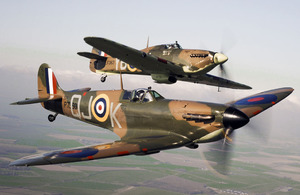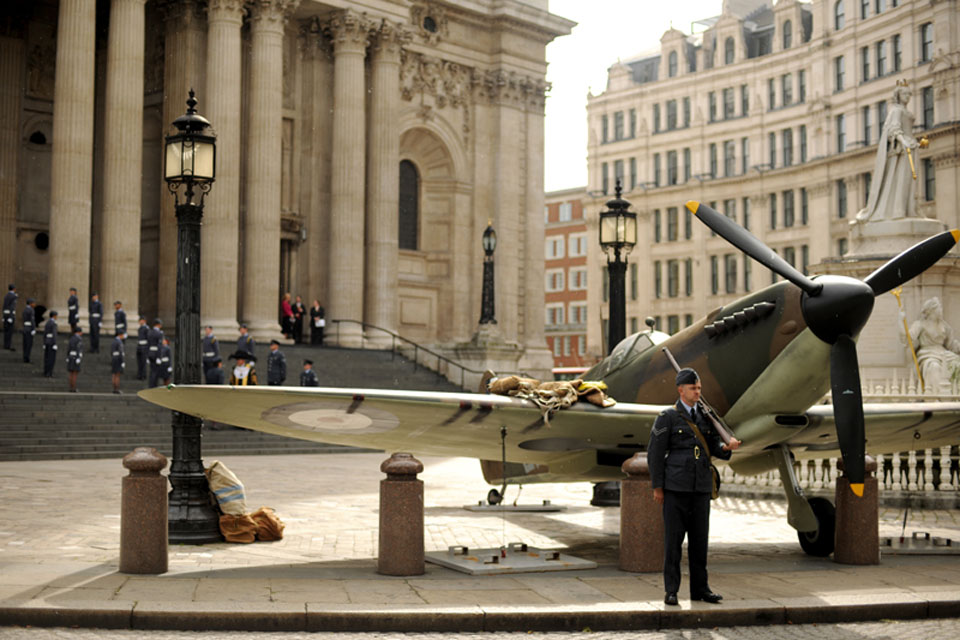IN PICTURES: Battle of Britain Day
Today, 15 September 2010, marks the 70th anniversary of the day which saw the peak air activity of the Battle of Britain and was described by the wartime Air Ministry as 'one of the greatest days'.

Spitfire P7350 (front) flies alongside Hurricane LF363 (back). The P7350 (Mk IIa) is the oldest airworthy Spitfire in the world and the only Spitfire still flying to have actually fought in the Battle of Britain [Picture: Senior Aircraftman Neil Chapman, Crown Copyright/MOD 2010]
The actions of that momentous day were described by Prime Minister Winston Churchill in the House of Commons as:
The most brilliant and fruitful of any fought upon a large scale up to that date by the fighters of the Royal Air Force.
Britain’s air defence rested principally on the Royal Air Force. While Bomber Command and Coastal Command would both make a significant contribution to the battle by attacking the German invasion preparations and airfields across the English Channel, and the Army’s anti-aircraft guns would inflict losses on any raiders, only the pilots of Fighter Command, under Air Chief Marshal Sir Hugh Dowding, could meet the Luftwaffe head on.
Nearly 3,000 aircrew would serve with Fighter Command in the course of the battle, of whom nearly 600 (around 20 per cent) were from the British dominions and occupied European or neutral countries.
To compensate for the lack of numbers, the RAF had the advantage of a highly efficient and advanced command and control system. At various levels in the command structure, operations rooms gathered and collated information gleaned from the radar sites that looked out from Britain’s coastline, from the volunteers who staffed Observer Corps posts further inland, from aircraft in the air, and other sources to build a remarkably accurate and near ‘real-time’ picture of the situation in the skies above.

A re-enactor dressed as a wartime airman guards a replica Spitfire outside St Paul's Cathedral in London as a special service is conducted to commemorate the 70th anniversary of the Battle of Britain [Picture: Senior Aircraftman Gareth Little, Crown Copyright/MOD 2010]
This allowed the commanders to direct their sparse resources towards the points where they were most needed, rather than wasting effort guarding empty skies.
The Battle of Britain acts as a touchstone for today’s RAF. The courage and self-sacrifice demonstrated serves as a continuing inspiration to serving personnel, and also acts as a constant reminder that the RAF’s foremost duty remains the control of the air.
The threat to the UK may have changed in character, and the ongoing control of the air mission in Afghanistan takes a very different form from the air battles over Kent and Sussex 70 years ago, but the objective remains the same: to secure the free use of the air for ourselves and our allies and to deny it to our adversaries.
Air Chief Marshal Sir Stephen Dalton, Chief of the Air Staff, said:
The summer of 1940 certainly saw an epic clash. It was only through the exercise of air power that the Nazis could bring pressure to bear and either force Britain to make peace or bypass Britain’s sea power and mount an invasion.
Air superiority over southern England and the Channel was the prerequisite. By denying that supremacy, the Royal Air Force saved Britain and ultimately laid the foundation to free Europe from the scourge of Nazism.
The airmen prepared to fight tyranny in a just cause were by no means all British; in all about one-fifth of them were from countries in the Commonwealth and Occupied Europe, or neutral nations.
It is with a sense of sorrow that we find that so many of the ‘Few’ died during the battle, and that of those still living in November 1940, close on half did not survive to see the final victory for which they fought. For their bravery and sacrifice in defence of our freedom, we will never forget them - indeed, we will remember them.
Additional Battle of Britain information and images can be found at Related Links.